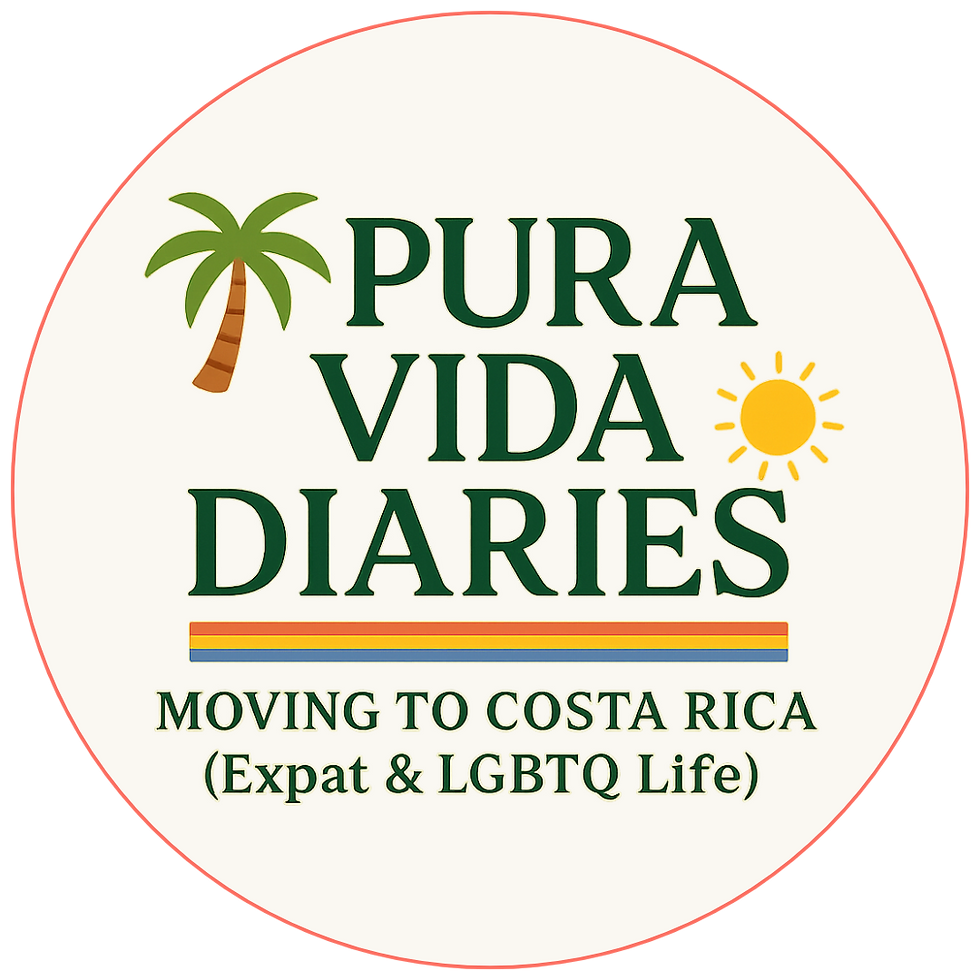Learning Spanish in Costa Rica: A Fun (and Honest) Guide for Expats Who Aren’t 22 Anymore
- Waymon Hudson

- Oct 22
- 4 min read
Updated: Nov 6

Moving to Costa Rica without speaking Spanish is like showing up to a potluck with no food or drinks — you can still have fun, but you’re going to miss out on half the conversations.
And listen, I get it. Learning Spanish in your 30s or 40s (or 50s, or however-young-you-feel) hits different. The brain isn’t quite the eager sponge it used to be, and you’ve got more on your plate than flashcards. But that’s no excuse to just smile, nod, and hope the waiter brings you something edible.
Learning Spanish in Costa Rica isn’t about perfection — it’s about connection.
1. Why You Need Spanish (Even If A Lot of People Speaks English)

Yes, many Costa Ricans — especially in tourist or expat-heavy towns — speak English. But if you want to:
Connect with your neighbors beyond “hola”
Negotiate rent without Google Translate
Understand your barista when she tells you your zipper’s down…you need Spanish.
It’s also just respectful. You’re living in someone else’s country. Meeting them halfway in their language opens doors — literally and culturally — that English never will.
2. Find a Local Teacher (and Learn the Real Stuff)

Forget the $500 online course taught by someone in Madrid who’s never even set foot in Costa Rica.
In Costa Rica, you can find local tutors for $10–$20/hour — and they’ll teach you how people actually talk here.
Pro tip: Ask around at your local coffee shop or post in your town’s Facebook group. That’s how I learned that “ahorita”doesn’t mean “right now” in Costa Rica (like it does in most other Spanish-speaksing countries). It means “eventually… maybe.” Life-changing.
3. Affordable Classes That Actually Work
If you want something structured, try these options:

🏫 Community Centers: Many towns offer group Spanish classes for expats.
📍 Language Schools: Top picks include Costa Rican Language Academy (San José) and Intercultura (Heredia & Sámara).
🎓 Universities: Some offer continuing education or audit options for Spanish learners.
Even a few weeks in a group class can give you the confidence to start conversations without panic-sweating.
4. Apps, AI & Digital Tools (Your Pocket Classroom)

Technology won’t make you fluent — but it’ll keep you consistent.
Duolingo: Great for vocab; not great for real-life phrases. (Nobody here is talking about penguins drinking milk.)
Italki: 1:1 lessons with native speakers — choose a Costa Rican tutor for slang and accent help.
Quizlet: Make flashcards for verbs, idioms, and phrases you’ll actually use.
AI Chat: Practice daily convo with ChatGPT in Spanish (make sure you specify Costa Rican Spanish) . It never rolls its eyes when you forget a word.

5. Practice in the Wild (Yes, You’ll Sound Silly)
The only way to get better is to embarrass yourself a little. Order your coffee in Spanish. Buy veggies at the feria without switching to English. Flirt — badly — in Spanish.
Locals will love the effort, even when your grammar sounds like a toddler’s. They’ll correct you, laugh with you, and cheer you on. And that’s the point — connection over perfection.
6. Learn the Local Lingo (Tico Spanish 101)
Costa Rican Spanish (“Tico Spanish”) has its own rhythm and slang.
Here’s your starter pack:

Tico / Tica: Costa Rican man/woman
Mae: Dude, bro, friend
Pura Vida: Hello, goodbye, thank you, “life’s good” — basically everything
Tuanis: Cool or awesome
Suave: Chill, relaxed, easygoing
Use these naturally and you’ll sound like you actually live here, not like you just landed for a yoga retreat.
7. Don’t Compare Yourself to a 22-Year-Old Exchange Student
You have responsibilities, bills, margaritas to drink... You’re not living in a dorm with six hours a day to study verbs — and that’s fine.
Progress over perfection. Celebrate every little win, like understanding the joke at the feria or having your first full conversation with your taxi driver.

Quick Takeaway:
Learning Spanish in Costa Rica isn’t just about mastering grammar. It’s about belonging. It’s how you go from tourist to neighbor, from “gringo who points” to “local who laughs.”
You don’t need perfect Spanish — you just need to try. And trust me, the effort will change your entire experience of life here.
Also check out the rest of the Pura Vida Diaries Blog Series:
Part 1: Moving to Costa Rica: Why I Chose Here Out of Anywhere in the World
Part 2: Thinking of Moving to Costa Rica? Cost of Living, Rent & Reality Check
Part 3: Residency in Costa Rica: How to Stay Legally (Without the Border-Run Headache)
Part 4: How to Be a Good Immigrant in Costa Rica (a.k.a. Don’t Be “That” Expat)
Part 6: Pets in Paradise: Bringing Your Dog or Cat to Costa Rica — and Why You Might Adopt One Here
Part 7: Culture Shock in Costa Rica: Why It’s the Best Thing That Ever Happened to Me (Pura Vida, Baby)
Part 9: Learning Spanish in Costa Rica: A Fun (and Honest) Guide for Expats Who Aren’t 22 Anymore
Part 10: Remote Work in Costa Rica: Jungle Wi-Fi, Time Zones, and the Digital Nomad Life
Part 11: Costa Rica Expat Challenges: The Hard Stuff No One Posts on Instagram
Basically? If you’ve ever Googled “Can I really move to Costa Rica?” …this series is your sign.
FAQ: Learning Spanish in Costa Rica
What’s the best way to learn Spanish in Costa Rica? Take lessons with local teachers, join community classes, and practice daily at markets, cafés, and with friends. Immersion is key — don’t rely only on apps.
Is Costa Rican Spanish different from regular Spanish?
Yes — it’s full of local slang and a softer accent. Common phrases like pura vida and tuanis are unique to Costa Rica’s friendly, laid-back culture.
Can I get by in Costa Rica without speaking Spanish?
In tourist areas, yes — but you’ll miss out on deeper connections and better deals. Learning basic Spanish makes everyday life smoother and more rewarding.
Are there Spanish schools for expats in Costa Rica?
Yes! Great options include Intercultura, Costa Rican Language Academy, and local community programs throughout the country.
How long does it take to learn Spanish in Costa Rica?
With consistent practice, most expats reach conversational level in 6–12 months — faster if you immerse yourself in local life.









Enjoyed your comments, try learning at 70+, the brain just refuses sometimes and short circuits. After 10 years still trying ever day. Poco a poco. I found a new app that provides good classes and more explanation than Duo. It's Airlearn and you can do 5 lessons a day for free. It's a good layer to overlay with Duo!